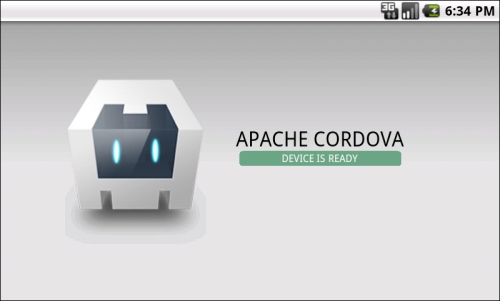Get ready to set up the Android development environment and to create a PhoneGap app using Android as target platform. Follow these steps:
Open the folder in which you unpacked the PhoneGap distribution, launch a command-line tool (Terminal on OS X or DOS Prompt on Windows) and change directories to the bin directory for Android:
$ cd PHONEGAP_ROOT/lib/android/binIn order to run the Android SKD tools, you must add them to the path where the Android tools reside. Use the command-line tool and mount the path (the paths vary depending on the location of the Android SDK):
$ export PATH=$PATH:~android-sdks/tools/$ export PATH=$PATH:~/android-sdks/platform-tools/In order to create a PhoneGap project, all you have to do is run the tool
./createfrom thebindirectory of android:$ ./create ~/PhoneGapProjects/PGGettinStarted/ch01/android com.gnstudio.samples.cordova.hello HelloPGThe tool actually needs three parameters: the path of the project files, the package of the project, and the name of the project. The tool creates an Android project including the folders and the files needed to debug, emulate, and build the PhoneGap app:
|-assets |---www |-bin |---res |-cordova |-gen |-libs |-res |-src
The root folder contains the
AndroidManifest.xmlfile; it's important that the package name and the activity name defined in the files match the arguments used when launching the./createcommand:<manifest xmlns:android="http: //schemas.android.com/apk/res/android" android:windowSoftInputMode="adjustPan" package="com.gnstudio.samples.cordova.hello" android:versionName="1.1" android:versionCode="5"> <activity android:name="HelloPG" android:label="@string/app_name" android:configChanges="orientation|keyboardHidden">
In the
wwwfolder you'll find the HTML/JS/CSS files needed to run the sample PhoneGap app bundled with the binary of the distribution. In order to run the application on the emulator, it's enough to run the app. Open a command-line tool and point to thecordovafolder, define the path to the Android SDK tools, and launch the./emulatecommand-line tool:$ cd ~/the/path/to/your/source/code/ch01/android/cordova$ export PATH=$PATH:~/android-sdks/tools/$ export PATH=$PATH:~/android-sdks/platform-tools/ $ ./emulate
The tool will check whether some virtual devices are already defined and prompt the user to define one if not. If there is more than one device already defined the tool will ask which one to use. When the selected device is loaded into the emulator you can debug the application; when launching the ./debug tool the app is installed and can be launched from the control panel of the emulator.
You created a PhoneGap project and emulated the HelloPG app in one of the testing devices configured within your Android SDK.

Tip
In order to correctly emulate the app on Windows you have to install the latest Android JDK, the Apache Ant binary, and the Android SDK. After all of those are installed add the path C:\Program Files\Java\jdk1.7.0_09\bin;C:\Users\YOUR_USER\Documents\apache-ant-1.8.4\bin;C:\Program Files (x86)\Android\android-sdk\tools to your path system variable. You can access the path system variable by navigating to Control Panel | System | Advanced System Settings | Advanced | Environment Variables | System Variables.



